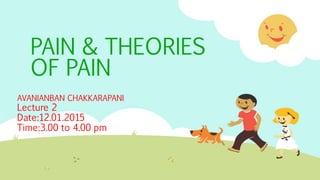
Pain & Theories of Pain
- 1. PAIN & THEORIES OF PAIN AVANIANBAN CHAKKARAPANI Lecture 2 Date:12.01.2015 Time:3.00 to 4.00 pm
- 2. Learning Objective To provide knowledge and understating of a. Pain Definition; b. Theories of pain(outline) ; and c. Pain gate theory in detail
- 3. Learning Outcome Able to explain meaning of pain, theories of pain Able to describe ‘ GATE CONTROL THEORY ’
- 4. PAIN MEANING/DEFINITION In 1968 McCaffery defined pain as “whatever the experiencing person says it is, existing whenever he/she says it does” In 1979 IASP defined pain as “unpleasant sensory and emotional experience associated with actual or potential tissue damage, or described in terms of suchdamage.” Pain from poena ---> Latin means punishment.
- 6. TYPES OF PAIN FIBRES TYPE OF NERVE CONDUCTION VELOCITY ( MTS/SEC ) MELINATED TYPE OF PAIN A- DELTA 20 (fast) YES SHARP, PRICKING, WELL LOCALIZED C 1 (slow) No DULL ACHE, DIFFUSE
- 8. DIFFERENT THEORIES OF PAIN Intensive Theory (Erb, 1874) ... Specificity Theory (Von Frey, 1895) ... Strong's Theory (Strong, 1895) ... Pattern Theory. ... Central Summation Theory (Livingstone, 1943) ... The Fourth Theory of Pain (Hardy, Wolff, and Goodell, 1940s) ... Sensory Interaction Theory (Noordenbos, 1959) ... Gate Control Theory (Melzack and Wall, 1965) √
- 9. PAIN MODULATION GATE CONTROL THEORY (WALL AND MELZACK 1965 )
- 10. GATE THEORY A gating mechanism exists within the dorsal horn of the spinal cord. Small nerve fibers (pain receptors) large nerve fibers ("normal" receptors) These two fibere synapse on projection cells (P), which go up the spinothalamic tract to the brain, and inhibitory interneurons (I) within the dorsal horn. The interplay among these connections determines when painful stimuli go to the brain
- 11. GATE THEORY When no input comes in, the inhibitory neuron prevents the projection neuron from sending signals to the brain (gate is closed).
- 12. GATE THEORY Normal somatosensory input happens when there is more large-fiber stimulation (or only large-fiber stimulation). Both the inhibitory neuron and the projection neuron are stimulated, but the inhibitory neuron prevents the projection neuron from sending signals to the brain (gate is closed).
- 13. GATE THEORY Nociception (pain reception) happens when there is more small-fiber stimulation or only small-fiber stimulation. This inactivates the inhibitory neuron, and the projection neuron sends signals to the brain informing it of pain (gate is open).
